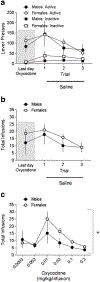Oxycodone self-administration in male and female rats
- PMID: 28127624
- PMCID: PMC7250466
- DOI: 10.1007/s00213-017-4536-6
Oxycodone self-administration in male and female rats
Abstract
Rationale: Oxycodone is one of the most widely prescribed painkillers in the USA. However, its use is complicated by high abuse potential. As sex differences have been described in drug addiction, the present study tested for sex differences in intravenous oxycodone self-administration in rats.
Methods: Male and female Sprague-Dawley rats were implanted with jugular vein catheters and trained to self-administer oxycodone (0.03 mg/kg/infusion) under fixed ratio 1 (FR1), FR2, and FR5 schedules of reinforcement followed by a dose-response study to assess sensitivity to the reinforcing effects of oxycodone. In separate rats, sucrose pellet self-administration was assessed under an FR1 schedule to determine whether sex differences in oxycodone self-administration could be generalized across reinforcers. In separate rats, oxycodone distribution to plasma and brain was measured after intravenous drug delivery.
Results: In the first 3 trials under an FR1 schedule of reinforcement, male rats self-administered more oxycodone than females. In contrast, females self-administered more sucrose pellets. Under FR2 and FR5 schedules, no significant sex differences in oxycodone intake were observed, although female rats had significantly more inactive lever presses. Male and female rats showed similar inverted U-shaped dose-effect functions, with females tending to self-administer more oxycodone than males at higher doses. No significant sex differences were observed in plasma or brain oxycodone levels, suggesting that sex differences in oxycodone self-administration behavior were not due to pharmacokinetics.
Conclusion: Our results suggest subtle sex differences in oxycodone self-administration, which may influence the abuse liability of oxycodone and have ramifications for prescription opioid addiction treatment.
Keywords: Motivation; Oxycodone; Self-administration; Sex differences; Sucrose reward.
Conflict of interest statement
Conflict of interest The authors declare that they have no conflict of interest.
Figures





Similar articles
-
MDPV "high-responder" rats also self-administer more oxycodone than their "low-responder" counterparts under a fixed ratio schedule of reinforcement.Psychopharmacology (Berl). 2021 Apr;238(4):1183-1192. doi: 10.1007/s00213-021-05764-4. Epub 2021 Jan 23. Psychopharmacology (Berl). 2021. PMID: 33484299
-
Chronic opioid exposure differentially modulates oxycodone self-administration in male and female rats.Addict Biol. 2021 May;26(3):e12973. doi: 10.1111/adb.12973. Epub 2020 Oct 19. Addict Biol. 2021. PMID: 33078503 Free PMC article.
-
Acute Negative Allosteric Modulation of M5 Muscarinic Acetylcholine Receptors Inhibits Oxycodone Self-Administration and Cue-Induced Reactivity with No Effect on Antinociception.ACS Chem Neurosci. 2019 Aug 21;10(8):3740-3750. doi: 10.1021/acschemneuro.9b00274. Epub 2019 Jul 24. ACS Chem Neurosci. 2019. PMID: 31268669 Free PMC article.
-
Environmental enrichment decreases intravenous amphetamine self-administration in rats: dose-response functions for fixed- and progressive-ratio schedules.Psychopharmacology (Berl). 2002 Aug;162(4):373-8. doi: 10.1007/s00213-002-1134-y. Epub 2002 Jun 7. Psychopharmacology (Berl). 2002. PMID: 12172690
-
Comparison of the reinforcing, antinociceptive, and respiratory depressant effects of prototypical and G-protein biased mu-opioid receptor agonists in male and female Sprague-Dawley rats.Psychopharmacology (Berl). 2024 Dec;241(12):2453-2469. doi: 10.1007/s00213-024-06690-x. Epub 2024 Sep 27. Psychopharmacology (Berl). 2024. PMID: 39333403
Cited by
-
Fentanyl self-administration is accelerated by methamphetamine co-use and results in worsened hypodopaminergia in male, but not female rats.Eur J Neurosci. 2024 Oct;60(8):5912-5926. doi: 10.1111/ejn.16533. Epub 2024 Sep 9. Eur J Neurosci. 2024. PMID: 39251212
-
Estrous cycle dependent expression of oxycodone conditioned reward in rats.Sci Rep. 2023 Aug 25;13(1):13946. doi: 10.1038/s41598-023-40971-3. Sci Rep. 2023. PMID: 37626154 Free PMC article.
-
Escalated Oxycodone Self-Administration and Punishment: Differential Expression of Opioid Receptors and Immediate Early Genes in the Rat Dorsal Striatum and Prefrontal Cortex.Front Neurosci. 2020 Jan 9;13:1392. doi: 10.3389/fnins.2019.01392. eCollection 2019. Front Neurosci. 2020. PMID: 31998063 Free PMC article.
-
Female and male rats readily consume and prefer oxycodone to water in a chronic, continuous access, two-bottle oral voluntary paradigm.Neuropharmacology. 2020 May 1;167:107978. doi: 10.1016/j.neuropharm.2020.107978. Epub 2020 Jan 27. Neuropharmacology. 2020. PMID: 32001238 Free PMC article.
-
Oral oxycodone self-administration leads to features of opioid misuse in male and female mice.Addict Biol. 2023 Jan;28(1):e13253. doi: 10.1111/adb.13253. Addict Biol. 2023. PMID: 36577735 Free PMC article.
References
-
- Bardo MT, Klebaur JE, Valone JM, Deaton C (2001) Environmental enrichment decreases intravenous self-administration of amphetamine in female and male rats. Psychopharmacology 155:278–284 - PubMed
-
- Carr KD (2002) Augmentation of drug reward by chronic food restriction: behavioral evidence and underlying mechanisms. Physiol Behav 76:353–364 - PubMed
-
- Carroll ME, Campbell UC, Heideman P (2001) Ketoconazole suppresses food restriction-induced increases in heroin self-administration in rats: sex differences. Exp Clin Psychopharmacol 9:307–316 - PubMed
MeSH terms
Substances
Grants and funding
LinkOut - more resources
Full Text Sources
Other Literature Sources
Research Materials

